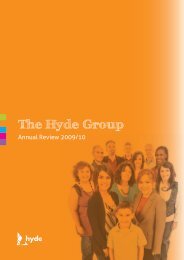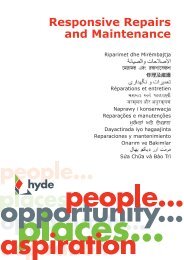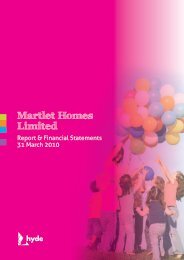Resident involvement - Hyde Housing Association
Resident involvement - Hyde Housing Association
Resident involvement - Hyde Housing Association
You also want an ePaper? Increase the reach of your titles
YUMPU automatically turns print PDFs into web optimized ePapers that Google loves.
<strong>Resident</strong> <strong>involvement</strong> in social housing in the UK and Europe<br />
expected to deliver – including a group-wide transfer scheme and improved<br />
customer services.<br />
‘It is fair to say that our tenant engagement here is more about how and<br />
when, rather than whether and why.’ [Senior manager, E2]<br />
At E3, however, the (part-resident) Customer Services Committee was seen as<br />
having a narrower, service-specific agenda. As seen by this provider, resident<br />
<strong>involvement</strong> on merger or stock rationalisation decisions was more<br />
appropriately managed via regional and local consultation.<br />
All the English case study landlords saw resident <strong>involvement</strong> as having an<br />
important bearing on organisational growth through mergers, in that a provider<br />
credibly portraying itself as resident-influenced could significantly enhance its<br />
attractiveness as a merger partner.<br />
‘We have a small group of tenants – most from the Federation – who our<br />
Growth team will take to regular meetings with prospective partners… Our<br />
history and record of active tenant engagement is often used as a positive<br />
offer in our discussions with prospective partners.’ [Senior manager, E2]<br />
Similarly, at E3 tenants involved at the regional and local level were involved in<br />
hosting visits by prospective partner organisations and their tenants.<br />
As regards growth through new development, a resident consultation exercise<br />
on the implications of the Government’s ‘affordable rent’ regime was underway<br />
at E2 at the time of the research. While the model’s cross-subsidy element had<br />
triggered concerns, the fact that the new higher rents would be limited to<br />
(some) new tenants rather than to existing tenants (see above) was thought reassuring.<br />
To engage tenants in hard policy choices, E2 had used a board game<br />
and participatory budgeting methods enabling them to prioritise a limited<br />
budget among new housebuilding, stock improvement, energy efficiency and<br />
community investment. ‘They almost always chose new development and<br />
growth as a priority.’<br />
At all three English case study landlords, resident <strong>involvement</strong> in decisions on<br />
stock rationalisation was seen as standard practice. At E1, this had recently<br />
included Customer Services Committee discussions on the methodology for<br />
selecting potential recipient landlords. At E2 and E3 <strong>involvement</strong> on this issue<br />
tended to have been more at regional and local levels.<br />
40
















